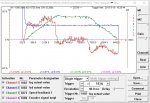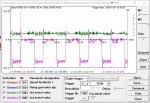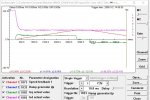anyone ever take Henry (L) measurements on input of live motor no-load then load?
can i possibly write the jX term as an expression that involve S (slip) ??
FZ, would real world impirical data suffice to prove to you the Xm does not change significantly loaded vs unloaded? Just the resistance term r'/s? It sure would be a lot easier to convince you than getting out my old college books and refreshing how to calculate L from 2piFL and Xm... Try these:
75kw during accel then no load running:
1) You can see red current to make torque to accelerate is around 40% of motor rating
2) you can see red running current (no load) is around 1%
3) you can see blue magnetizing current is constant 25% AT ALL TIMES.
Although it is irrelevant, for reference, 100% speed on this 100HP motor is 12,000rpm, 100% current is 188 amps @ 8khz PWM. Bottom line is NO CHANGE in Xm (aka J) term even tho LOAD changed from 1 to 40%. PF (aka, phase angle) changed but not imaginary current.
200kw while machining in and out of part:
1) You can see purple current to make torque to machine @ 200HP is 100% of motor rating
2) you can see purple running current (no load) is around 0.5%
3) you can see blue magnetizing current is constant 20% AT ALL TIMES.
Although it is irrelevant, for reference, 100% speed on this 100HP motor is 18,000rpm, 100% current is 200 amps @ 12khz PWM. Bottom line is NO CHANGE in Xm (aka J) term even tho LOAD changed from 1 to 100%. PF (aka, phase angle) changed but not imaginary current.
75kw,10k during accel, run no load, then decel:
1) You can see green current to make torque to accelerate is around 15% of motor rating
2) you can see green running current (no load) is around 0.5%
3) you can see purple magnetizing current is constant 32% AT ALL TIMES.
Although it is irrelevant, for reference, 100% speed on this 75HP motor is 10,000rpm, 100% current is 100 amps @ 5khz PWM. Bottom line is NO CHANGE in Xm (aka J) term even tho LOAD changed from 1 to 15%. PF (aka, phase angle) changed but not imaginary current.
I hope these real scope pixs are enough proof FZ that reactance/X/J do NOT change with load - only the r'/s term that is the Isq IN PHASE current you pay for.
I have a zillion more scope pix of the imaginary current along with the real current I can share. From drives from 2kw to the 200kw sizes. But the bottom line is all show the same thing! Some motor designs DO lead themselves to 10-20% variations in Isq loaded vs unloaded, but NOT for the reasons of morphing! But since some designs have more leakage reactance than others. But that is irrelevant to these discussions, just like starting current is irrelevant. Although once THIS is understood, then the huge starting current pulse is very easy to understand too (all related again to R'/s during start).
If you need further proof, maybe someone who runs Z=R+Jw calcs daily can convert these values for you into L as you ask. I do not want to.
ADDED note: I am only showing you scope pictures BELOW BASE SPEED, or at a constant speed here. I did not want to introduce how the magnetizing current must go down when we get into the field weakening range... Brrhhh not yet anyway!




